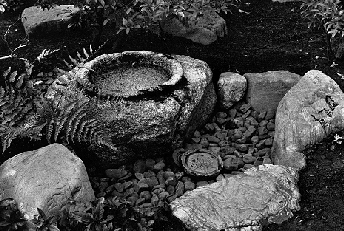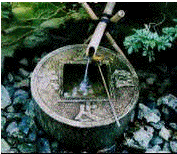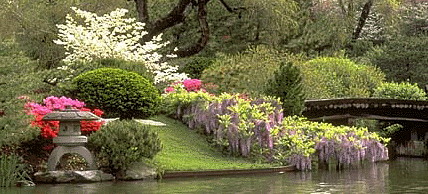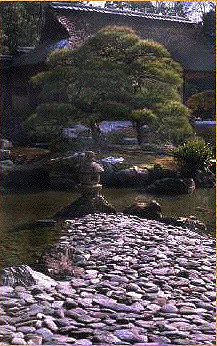

There are two kinds of stone water basins.
One is ornamental, kazari- chozubachi,
which is kept near the verandah while the other is for the tea garden,
called tsukubai. The image above is
an example of the tsukubai. As you
can see, it is kept very low so that the visitor must kneel down in order
to wash his hands. The other stones that surround the basin are set in
a specific manner:
2. Yutoseki (on the right) 3. Teshoku- ishi (on the left) |
|
| There is an area left in the middle, or the hollow, which is where the water is disposed. This area is covered by smaller rocks and pebbles. Although originally meant for the tea ceremonies, these basins are used in other gardens as well. |
 |
The second type of stone water basin is
raised. In this way, the visitor can use it standing up. Such basins
are usually placed by the short fence, or the sodegaki,
adding to the aesthetic experience. The tsukubaiis
surrounded by four other stones:
2. Seijoseki (Cleaning Stones) 3. Mizukumi- ishi (Water- Drawing Stone) 4. Mizuage- ishi (Water- Bringing Stone) |
| The stone water basins are made of natural or lightly worked stones. The water basin is replenished frequently by bamboo pipes, as you can see in the image above. A stone lantern is usually near the stone water basin, contributing to the overall aesthetic effect of the Japanese ga rden. |
 |
| During the tea ceremonies of the Momoyama period, temple dedication lanterns were used to provide a dim light. The subtle luminescence of the lantern underscored the unfinished beauty of the tea aesthetic. It is from this ritual that the stone lantern emerged in other Japanese gardens. |
 |
|
|
|
|
|
|
|
|
|
|
|
|
|
|
|
|
|
|
|
|
|
|
|
|
|
|
|